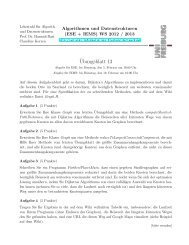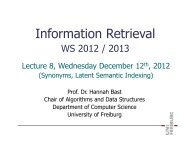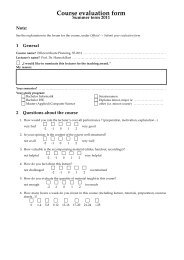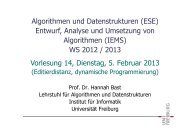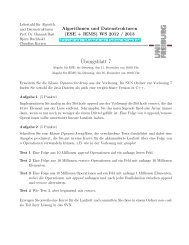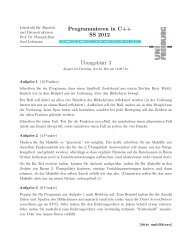Lexicalized Tree-Adjoining Grammars (LTAG) - ad-teaching.infor...
Lexicalized Tree-Adjoining Grammars (LTAG) - ad-teaching.infor...
Lexicalized Tree-Adjoining Grammars (LTAG) - ad-teaching.infor...
Create successful ePaper yourself
Turn your PDF publications into a flip-book with our unique Google optimized e-Paper software.
<strong>Lexicalized</strong> <strong>Tree</strong>-<strong>Adjoining</strong> <strong>Grammars</strong> (<strong>LTAG</strong>)<br />
Fabian Reiter<br />
January 18, 2012
Our Goal<br />
We want to generate syntax trees like this:<br />
S<br />
NP<br />
VP<br />
D<br />
N<br />
often<br />
VP<br />
the<br />
penguin<br />
V<br />
NP<br />
chases<br />
D<br />
the<br />
N<br />
elephant<br />
2 / 52
Context-Free <strong>Grammars</strong><br />
Definition (Context-Free Grammar)<br />
A context-free grammar (CFG) is a 4-tuple G = (N, T , P, S)<br />
where:<br />
N is a finite set of non-terminal symbols.<br />
T is a finite set of terminal symbols, N ∩ T = ∅.<br />
P ⊆ N × (N ∪ T ) ∗ is a finite set of production rules.<br />
S ∈ N is a specific start symbol.<br />
Example<br />
G = (N, T , P, S)<br />
where:<br />
N = {S, NP, D, N, VP, V}<br />
T = {often, chases, helps,<br />
the, penguin, elephant}<br />
P :<br />
S → NP VP<br />
NP → D N<br />
D → the<br />
N → penguin ∣ ∣ elephant<br />
VP → often VP ∣ ∣ V NP<br />
V → chases ∣ ∣ helps<br />
3 / 52
Context-Free <strong>Grammars</strong><br />
Example (Derivation with a CFG)<br />
G = (N, T , P, S)<br />
where:<br />
N = {S, NP, D, N, VP, V}<br />
T = {often, chases, helps,<br />
the, penguin, elephant}<br />
S<br />
P :<br />
S → NP VP<br />
NP → D N<br />
D → the<br />
N → penguin ∣ ∣ elephant<br />
VP → often VP ∣ ∣ V NP<br />
V → chases ∣ ∣ helps<br />
NP<br />
VP<br />
D<br />
N<br />
often<br />
VP<br />
the<br />
penguin<br />
V<br />
NP<br />
chases<br />
D<br />
the<br />
N<br />
elephant<br />
4 / 52
<strong>Tree</strong>-Substitution <strong>Grammars</strong><br />
Example (Derivation with a TSG)<br />
Initial trees:<br />
S<br />
NP<br />
D<br />
N<br />
N<br />
NP↓<br />
VP↓<br />
D↓<br />
N↓<br />
the<br />
penguin<br />
elephant<br />
VP<br />
VP<br />
V<br />
V<br />
often<br />
VP↓<br />
V↓<br />
NP↓<br />
chases<br />
helps<br />
A derived tree:<br />
S<br />
NP<br />
VP<br />
D<br />
N<br />
often<br />
VP<br />
the<br />
penguin<br />
V<br />
NP<br />
chases<br />
D<br />
N<br />
the<br />
elephant<br />
5 / 52
<strong>Tree</strong>-<strong>Adjoining</strong> <strong>Grammars</strong><br />
Example (Derivation with a TAG)<br />
Initial trees:<br />
S<br />
NP NP D<br />
NP↓ VP D↓ N D↓ N the<br />
V<br />
chases<br />
NP↓ penguin elephant<br />
Auxiliary tree:<br />
VP<br />
often VP ∗<br />
A derived tree:<br />
S<br />
NP<br />
VP<br />
D N often VP<br />
the penguin V NP<br />
chases D<br />
the<br />
N<br />
elephant<br />
6 / 52
Outline<br />
1 Why CFGs are not enough (for linguists)<br />
2 Introduction to <strong>Tree</strong>-<strong>Adjoining</strong> <strong>Grammars</strong><br />
3 An Algorithm for Parsing TAGs<br />
4 <strong>LTAG</strong>-Spinal Parser<br />
7 / 52
Outline<br />
1 Why CFGs are not enough (for linguists)<br />
Generative capacity<br />
Lexicalization<br />
2 Introduction to <strong>Tree</strong>-<strong>Adjoining</strong> <strong>Grammars</strong><br />
3 An Algorithm for Parsing TAGs<br />
4 <strong>LTAG</strong>-Spinal Parser<br />
8 / 52
Cross-Serial Dependencies<br />
Example (Swiss German; Shieber, 1985)<br />
b a b a<br />
. . . das mer em Hans es huus hälfed aastriiche<br />
. . . that we Hans DAT house ACC helped paint<br />
‘. . . that we helped Hans paint the house’<br />
a b a a b a<br />
. . . das mer d’chind em Hans es huus lönd hälfe aastriiche<br />
. . . that we the children ACC Hans DAT house ACC let help paint<br />
‘. . . that we let the children help Hans paint the house’<br />
This can be reduced to the copy language {ww | w ∈ {a, b} ∗ }<br />
which is not context-free.<br />
9 / 52
Lexicalization<br />
A grammar is lexicalized if each elementary structure is associated<br />
with at least one lexical item (terminal symbol), called its anchor.<br />
Example (<strong>Lexicalized</strong> CFG)<br />
S → Mary V ∣ ∣ John V<br />
V → runs<br />
Example (Non-lex. CFG)<br />
S → N V<br />
N → Mary ∣ John<br />
V → runs<br />
Weak lexicalization of a grammar:<br />
Find a lexicalized grammar generating the same string language.<br />
Strong lexicalization of a grammar:<br />
Find a lexicalized grammar generating the same tree language.<br />
10 / 52
Lexicalization<br />
Example (<strong>Lexicalized</strong> initial trees)<br />
NP<br />
S<br />
S<br />
N<br />
NP↓<br />
VP<br />
NP↓<br />
VP<br />
Mary<br />
V<br />
eats<br />
NP↓<br />
V<br />
takes<br />
NP↓<br />
PP<br />
P NP<br />
into N<br />
account<br />
Example (Non-lexicalized initial trees)<br />
NP<br />
S<br />
S<br />
D↓<br />
N↓<br />
NP↓<br />
VP↓<br />
NP↓<br />
VP<br />
V↓<br />
NP↓<br />
11 / 52
Why Lexicalization<br />
Syntactic structures associated with single words can be seen<br />
as more powerful POS-tags (“supertags”).<br />
Example (Transitive vs. intransitive verb)<br />
NP↓<br />
S<br />
V<br />
eats<br />
VP<br />
NP↓<br />
NP↓<br />
S<br />
VP<br />
V<br />
sleeps<br />
(Finite) lexicalized grammars are finitely ambiguous.<br />
⇒ The generated string languages are decidable.<br />
Lexicalization is useful for parsing since it allows us to<br />
drastically restrict the search space (as a preprocessing step).<br />
12 / 52
Lexicalization<br />
Example (CFG which is not strongly lexicalizable with a TSG)<br />
Consider the following CFG:<br />
An intuitive approach to lexicalize<br />
it with a TSG might be:<br />
S → SS<br />
S → a<br />
S<br />
a<br />
S↓<br />
S<br />
S<br />
S<br />
S<br />
S↓<br />
But this is not a strong lexicalization<br />
because it cannot generate the following<br />
tree (which the CFG can generate):<br />
S<br />
a<br />
S<br />
a<br />
S<br />
S<br />
S<br />
S<br />
S<br />
Problem: In TSGs the distance between two nodes in the same<br />
initial tree cannot increase during derivation.<br />
a<br />
a<br />
a<br />
a<br />
13 / 52
Linguistic Shortcomings of CFG<br />
Proposition (Shieber, 1985)<br />
The language L of Swiss German is not context-free.<br />
Proposition (Joshi and Schabes, 1997)<br />
CFG cannot be strongly lexicalized by TSG (or CFG).<br />
14 / 52
Outline<br />
1 Why CFGs are not enough (for linguists)<br />
2 Introduction to <strong>Tree</strong>-<strong>Adjoining</strong> <strong>Grammars</strong><br />
The formalism<br />
What we can do with it<br />
3 An Algorithm for Parsing TAGs<br />
4 <strong>LTAG</strong>-Spinal Parser<br />
15 / 52
<strong>Tree</strong>-<strong>Adjoining</strong> <strong>Grammars</strong><br />
Definition (<strong>Tree</strong>-<strong>Adjoining</strong> Grammar)<br />
A tree-<strong>ad</strong>joining grammar (TAG) is a 5-tuple G = (N, T , I , A, S)<br />
where:<br />
N is a finite set of non-terminal symbols.<br />
T is a finite set of terminal symbols, N ∩ T = ∅.<br />
I is a finite set of initial trees.<br />
A is a finite set of auxiliary trees.<br />
S ∈ N is a specific start symbol.<br />
The trees in I ∪ A are called elementary trees.<br />
A <strong>Tree</strong>-Substitution Grammar (TSG) is defined analogously as a<br />
4-tuple G = (N, T , I , S), i.e. a TAG without auxiliary trees.<br />
16 / 52
Initial <strong>Tree</strong>s<br />
Definition (Initial <strong>Tree</strong>)<br />
An initial tree is characterized as follows:<br />
Example<br />
Internal nodes are only labeled by non-terminal symbols.<br />
Leaf nodes are labeled by terminals or non-terminals.<br />
If a leaf is labeled by a non-terminal, it is marked as<br />
substitution node (indicated by the symbol “↓”).<br />
D<br />
NP<br />
NP<br />
S<br />
S<br />
a<br />
D↓<br />
N<br />
N<br />
NP↓<br />
VP<br />
NP↓<br />
VP<br />
cat<br />
Mary<br />
V<br />
NP↓<br />
V<br />
NP↓<br />
PP<br />
saw<br />
gives<br />
P<br />
NP↓<br />
to<br />
17 / 52
Auxiliary <strong>Tree</strong>s<br />
Definition (Auxiliary <strong>Tree</strong>)<br />
An auxiliary tree has the same properties as an initial tree apart<br />
from one exception:<br />
Example<br />
Exactly one of the leaves labeled by a non-terminal is marked<br />
as the foot node (indicated by the symbol “∗”) inste<strong>ad</strong> of<br />
being marked for substitution. The label of the foot node<br />
must be identical to the label of the root node.<br />
N<br />
A<br />
S<br />
S<br />
A<br />
N ∗<br />
Adv<br />
A ∗<br />
Adv<br />
S ∗<br />
NP↓<br />
VP<br />
green<br />
very<br />
yesterday<br />
V<br />
S<br />
thinks<br />
Comp<br />
that<br />
S ∗<br />
18 / 52
Substitution<br />
Definition (Substitution)<br />
Let γ be a tree containing a substitution node n labeled by X and<br />
α an initial tree whose root node is also labeled by X.<br />
By applying the substitution operation on (γ, n) and α, one gets a<br />
copy γ ′ of γ in which n has been replaced by α. If γ, n, α do not<br />
fulfill the above conditions, the operation is undefined.<br />
S<br />
X<br />
X<br />
S<br />
X<br />
γ α γ ′ 19 / 52
Substitution<br />
Example (Substitution)<br />
S<br />
NP<br />
N<br />
Mary<br />
NP↓<br />
VP<br />
V NP↓<br />
saw<br />
S<br />
D<br />
a<br />
NP<br />
D↓ N<br />
cat<br />
NP<br />
VP<br />
N<br />
V<br />
NP<br />
Mary<br />
saw<br />
D<br />
N<br />
a<br />
cat<br />
20 / 52
Adjunction<br />
Definition (Adjunction)<br />
Let γ be a tree containing an internal node n labeled by X and<br />
β an auxiliary tree whose root node is also labeled by X.<br />
By applying the <strong>ad</strong>junction operation on (γ, n) and β, one gets a<br />
copy γ ′ of γ in which β has taken the place of the subtree t rooted<br />
by n and t has been attached to the foot node of β. If γ, n, β do<br />
not fulfill the above conditions, the operation is undefined.<br />
S<br />
X<br />
X<br />
S<br />
X<br />
∗<br />
γ β<br />
γ ′<br />
X<br />
X ∗ 21 / 52
Adjunction<br />
Example (Adjunction)<br />
Adv<br />
S<br />
yesterday<br />
S ∗<br />
S<br />
NP VP<br />
N V NP<br />
Mary<br />
S<br />
saw D<br />
a<br />
N<br />
cat<br />
Adv<br />
S<br />
yesterday NP VP<br />
N V NP<br />
Mary saw D N<br />
a A<br />
green<br />
N<br />
cat<br />
N<br />
A<br />
green<br />
N ∗<br />
22 / 52
Adjunction Constraints<br />
Given TAG G = (N, T , I , A, S)<br />
We specify for each node n of a tree in I ∪ A:<br />
OA ∈ {⊥, ⊤} : obligatory <strong>ad</strong>junction<br />
Boolean specifying whether <strong>ad</strong>junction at n is mandatory<br />
SA ⊆ A : selective <strong>ad</strong>junction<br />
Set of auxiliary trees authorized for <strong>ad</strong>junction at n<br />
Also often used:<br />
NA ∈ {⊥, ⊤} : null <strong>ad</strong>junction<br />
Shorthand for the special case OA = ⊥ ∧ SA = ∅<br />
Remarks<br />
• OA = ⊤ ∧ SA = ∅ is not allowed.<br />
• β ∈ SA(n) only if root label of β equal to label of n.<br />
• Substitution nodes must have NA = ⊤.<br />
23 / 52
Cross-Serial Dependencies<br />
Example (TAG for the copy language)<br />
Generated string language:<br />
{ww | w ∈ {a, b} ∗ }<br />
a<br />
S NA<br />
S<br />
a<br />
S NA<br />
S NA<br />
S<br />
ε<br />
a<br />
S NA<br />
S<br />
S ∗ NA<br />
a<br />
b<br />
Elementary trees<br />
S NA<br />
S<br />
S ∗ NA<br />
b<br />
S ∗ NA<br />
ε<br />
a<br />
b<br />
S<br />
S ∗ NA<br />
S ∗ NA<br />
b<br />
a<br />
ε<br />
Some derived trees<br />
24 / 52
Lexicalization<br />
Example (strong lexicalization of a CFG with a TAG)<br />
Consider again the following CFG:<br />
It can be easily lexicalized with a<br />
TAG by using <strong>ad</strong>junction:<br />
S → SS<br />
S → a<br />
S<br />
a<br />
S ∗<br />
S<br />
S<br />
a<br />
By successive <strong>ad</strong>junction we get the following derived trees:<br />
S S S<br />
S<br />
a<br />
S<br />
S<br />
S<br />
S<br />
S<br />
S<br />
a<br />
a<br />
a<br />
S<br />
S<br />
S<br />
S<br />
S<br />
S<br />
a<br />
a<br />
a<br />
a<br />
a<br />
a<br />
25 / 52
Lexicalization<br />
Proposition (Joshi and Schabes, 1997)<br />
Finitely ambiguous CFGs can be strongly lexicalized by TAGs.<br />
Proposition (Joshi and Schabes, 1997)<br />
Finitely ambiguous TAGs are closed under strong lexicalization.<br />
26 / 52
Further Formal Properties of TAL<br />
<strong>Tree</strong>-<strong>Adjoining</strong> Languages (TAL) have interesting formal<br />
properties, similar to those of context-free languages:<br />
TALs are closed under union, concatenation, iteration,<br />
substitution and intersection with regular languages.<br />
There is a pumping lemma for TAL.<br />
There is a class of automata which recognizes TAL:<br />
Embedded Push-Down Automata (EPDA).<br />
TALs can be parsed in polynomial time.<br />
27 / 52
Outline<br />
1 Why CFGs are not enough (for linguists)<br />
2 Introduction to <strong>Tree</strong>-<strong>Adjoining</strong> <strong>Grammars</strong><br />
3 An Algorithm for Parsing TAGs<br />
Preliminaries<br />
The Recognizer Algorithm<br />
Complexity and Extensibility<br />
4 <strong>LTAG</strong>-Spinal Parser<br />
28 / 52
TAG Parsing<br />
Parser: Given a string s and a TAG G = (N, T , I , A, S),<br />
find all derived trees in L tree (G) which yield s.<br />
We will start with a simpler problem:<br />
Recognizer: Given a string s and a TAG G = (N, T , I , A, S),<br />
decide whether s ∈ L string (G).<br />
Further simplification:<br />
We will only consider the <strong>ad</strong>junction operation for now.<br />
29 / 52
<strong>Tree</strong> Traversal<br />
The algorithm will traverse every eligible derived tree (Euler tour)<br />
while scanning the input string from left to right.<br />
Start<br />
End<br />
A<br />
Left context,<br />
alre<strong>ad</strong>y traversed<br />
Right context,<br />
to be traversed<br />
B<br />
C<br />
D<br />
A<br />
E F G H I<br />
30 / 52
Recognizing Adjunction<br />
But the algorithm never builds derived trees! It only uses the<br />
elementary trees of the input grammar.<br />
Suppose that the following <strong>ad</strong>junction took place:<br />
A<br />
A<br />
=<br />
A<br />
(α) (β) (γ) w 1 w 5<br />
A<br />
A<br />
w 1 w 3 w 5 w 2 w w 4 2 w 4<br />
w 3<br />
We need to traverse the derived tree γ but only have α and β at<br />
our disposal.<br />
31 / 52
Recognizing Adjunction<br />
If we could traverse γ, we would follow the path<br />
· · · 1 ′′ · · · 2 ′′ · · · 3 ′′ · · · 4 ′′ · · ·<br />
(1') (4') (1")<br />
(4")<br />
(1)<br />
(4)<br />
A<br />
A<br />
(α)<br />
A<br />
(β) (γ)<br />
(2) (3)<br />
w 1 w 5<br />
A<br />
A<br />
w 1 w 3 w 5 w 2 w w 4 2 w 4<br />
(2') (3') (2")<br />
(3")<br />
w 3<br />
This can be simulated by traversing α and β such that the dots<br />
around the nodes labeled by A are visited in the following order:<br />
· · · 1 1 ′ · · · 2 ′ 2 · · · 3 3 ′ · · · 4 ′ · · · 4 · · ·<br />
32 / 52
Dotted <strong>Tree</strong><br />
We introduce the notion of dotted tree.<br />
It consists of:<br />
a tree γ<br />
a dot location (<strong>ad</strong>r, pos)<br />
where<br />
• <strong>ad</strong>r is the Gorn <strong>ad</strong>dress of<br />
a node in γ.<br />
• pos ∈ {la, lb, rb, ra} is a<br />
relative position.<br />
Definition (Gorn Address)<br />
Given a node n in a tree γ, the Gorn<br />
<strong>ad</strong>dress of n is:<br />
0, if n is the root<br />
k, if n is the k th child of the root<br />
<strong>ad</strong>r.k, if n is the k th child of the<br />
node at <strong>ad</strong>dress <strong>ad</strong>r, <strong>ad</strong>r ≠ 0<br />
Start<br />
B<br />
A<br />
C<br />
End<br />
D<br />
(γ)<br />
E F G H I<br />
Example (Dotted trees)<br />
〈γ, 0, la〉 ( • A )<br />
〈γ, 3, rb〉<br />
( D •)<br />
〈γ, 2.1, ra〉 ( E • )<br />
33 / 52
Equivalent Dot Positions<br />
For the sake of convenience we will consider equivalent two<br />
successive dot positions (according to the tree traversal) that do<br />
not cross a node in the tree.<br />
(γ)<br />
B<br />
A<br />
C D<br />
E F G H I<br />
Example (Equivalent dotted trees)<br />
〈γ, 0, lb〉 ≡ 〈γ, 1, la〉<br />
〈γ, 1, ra〉 ≡ 〈γ, 2, la〉<br />
〈γ, 2, lb〉 ≡ 〈γ, 2.1, la〉<br />
34 / 52
Chart Items<br />
The algorithm stores intermediate results in a set of items called chart.<br />
Each item contains a dotted elementary tree and the corresponding range<br />
of the input string which has been recognized (by this item).<br />
Definition (Chart Item)<br />
An item is an 8-tuple [γ, <strong>ad</strong>r, pos, i, j, k, l, <strong>ad</strong>j]<br />
where<br />
γ ∈ I ∪ A is an elementary tree.<br />
<strong>ad</strong>r is the Gorn <strong>ad</strong>dress of a node in γ.<br />
pos ∈ {la, lb, rb, ra} is a relative position.<br />
i, j, k, l are indices on the input string.<br />
i, l delimit the range spanned by the<br />
dotted node and its left sibling nodes.<br />
j, k delimit the gap below the foot note if<br />
it exists. Otherwise their values are −.<br />
<strong>ad</strong>j ∈ {⊥, ⊤} is a boolean indicating<br />
whether an <strong>ad</strong>junction has been<br />
recognized at <strong>ad</strong>dress <strong>ad</strong>r in γ.<br />
X<br />
X0<br />
(γ)<br />
... ...<br />
X 1<br />
... X y ... X z<br />
c ... i+1<br />
X<br />
c j c ... k+1 c l<br />
c ... j+1<br />
c k<br />
35 / 52
Outline of the Algorithm<br />
Initialize the chart C with items of the form<br />
[α, 0, la, 0, −, −, 0, ⊥], where α ∈ I , root label S.<br />
Then use 4 types of operations to <strong>ad</strong>d new items to C:<br />
Scan, Predict, Complete, Adjoin<br />
Operations stated as inference rules:<br />
item 1 · · · item m<br />
item ∗<br />
conditions<br />
Add item ∗ to C if item 1 ,· · ·, item m ∈ C and conditions are met.<br />
Accept input string c 1 · · · c n if C contains at least one item<br />
[α, 0, ra, 0, −, −, n, ⊥], where α ∈ I , root label S.<br />
36 / 52
Scan Operations<br />
Input string: c 1 · · · c n<br />
Input TAG: G = (N, T , I , A, S)<br />
1<br />
[γ, <strong>ad</strong>r, la, i, j, k, l, ⊥]<br />
[γ, <strong>ad</strong>r, ra, i, j, k, l + 1, ⊥]<br />
γ(<strong>ad</strong>r) ∈ T ,<br />
γ(<strong>ad</strong>r) = c l+1<br />
a = c l + 1<br />
a<br />
[i,j,k,l,⊥]<br />
a<br />
[i,j,k,l+1,⊥]<br />
2<br />
[γ, <strong>ad</strong>r, la, i, j, k, l, ⊥]<br />
[γ, <strong>ad</strong>r, ra, i, j, k, l, ⊥]<br />
γ(<strong>ad</strong>r) = ε<br />
ε<br />
[i,j,k,l,⊥]<br />
ε<br />
[i,j,k,l,⊥]<br />
37 / 52
Predict Operations<br />
1<br />
[γ, <strong>ad</strong>r, la, i, j, k, l, ⊥]<br />
[β, 0, la, l, −, −, l, ⊥]<br />
γ(<strong>ad</strong>r) ∈ N,<br />
β ∈ SA(γ, <strong>ad</strong>r)<br />
A<br />
[i,j,k,l,⊥]<br />
A<br />
A<br />
[l,-,-,l,⊥]<br />
2<br />
[γ, <strong>ad</strong>r, la, i, j, k, l, ⊥]<br />
[γ, <strong>ad</strong>r, lb, l, −, −, l, ⊥]<br />
γ(<strong>ad</strong>r) ∈ N,<br />
OA(γ, <strong>ad</strong>r) = ⊥<br />
A<br />
[i,j,k,l,⊥]<br />
A<br />
[l,-,-,l,⊥]<br />
3<br />
[β, <strong>ad</strong>r, lb, l, −, −, l, ⊥]<br />
[γ, <strong>ad</strong>r ′ , lb, l, −, −, l, ⊥]<br />
A<br />
<strong>ad</strong>r = foot(β),<br />
β ∈ SA(γ, <strong>ad</strong>r ′ )<br />
A<br />
[l,-,-,l,⊥]<br />
A<br />
[l,-,-,l,⊥]<br />
38 / 52
Complete Operations<br />
1<br />
2<br />
3<br />
[γ, <strong>ad</strong>r, rb, i, j, k, l, ⊥] [β, <strong>ad</strong>r ′ , lb, i, −, −, i, ⊥] <strong>ad</strong>r ′ = foot(β),<br />
[β, <strong>ad</strong>r ′ , rb, i, i, l, l, ⊥]<br />
β ∈ SA(γ, <strong>ad</strong>r)<br />
+<br />
A<br />
A<br />
[i,j,k,l,⊥]<br />
[i,-,-,i,⊥]<br />
A<br />
A<br />
A<br />
[i,i,l,l,⊥]<br />
[γ, <strong>ad</strong>r, rb, i, j, k, l, <strong>ad</strong>j] [γ, <strong>ad</strong>r, la, h, −, −, i, ⊥]<br />
γ(<strong>ad</strong>r) ∈ N<br />
[γ, <strong>ad</strong>r, ra, h, j, k, l, ⊥]<br />
B<br />
A<br />
B<br />
[i,j,k,l,<strong>ad</strong>j]<br />
+<br />
B<br />
B<br />
A<br />
A<br />
B<br />
B<br />
[h,-,-,i,⊥]<br />
[h,j,k,l,⊥]<br />
[γ, <strong>ad</strong>r, rb, i, −, −, l, <strong>ad</strong>j] [γ, <strong>ad</strong>r, la, h, j, k, i, ⊥]<br />
γ(<strong>ad</strong>r) ∈ N<br />
[γ, <strong>ad</strong>r, ra, h, j, k, l, ⊥]<br />
A<br />
+<br />
A<br />
A<br />
[i,-,-,l,<strong>ad</strong>j]<br />
[h,j,k,i,⊥]<br />
[h,j,k,l,⊥]<br />
39 / 52
Adjoin Operation<br />
[β, 0, ra, i, j, k, l, ⊥] [γ, <strong>ad</strong>r, rb, j, p, q, k, ⊥]<br />
[γ, <strong>ad</strong>r, rb, i, p, q, l, ⊤]<br />
β ∈ SA(γ, <strong>ad</strong>r)<br />
A<br />
A<br />
[i,j,k,l,⊥]<br />
+<br />
A<br />
[j,p,q,k,⊥]<br />
A<br />
[i,p,q,l,⊤]<br />
40 / 52
Recognizer Algorithm<br />
Algorithm (Recognizer; Joshi and Schabes, 1997)<br />
Input: String c 1 · · · c n<br />
TAG G = (N, T , I , A, S) (that only allows <strong>ad</strong>junction)<br />
{<br />
}<br />
Initialize: C := [α, 0, la, 0, −, −, 0, ⊥] ∣ α ∈ I , α(0) = S<br />
While ( new items can be <strong>ad</strong>ded to C )<br />
apply the following operations on each item in C:<br />
[γ, <strong>ad</strong>r, la, i, j, k, l, ⊥]<br />
[γ, <strong>ad</strong>r, ra, i, j, k, l + 1, ⊥]<br />
[γ, <strong>ad</strong>r, la, i, j, k, l, ⊥]<br />
[γ, <strong>ad</strong>r, ra, i, j, k, l, ⊥]<br />
[γ, <strong>ad</strong>r, la, i, j, k, l, ⊥]<br />
[β, 0, la, l, −, −, l, ⊥]<br />
[γ, <strong>ad</strong>r, la, i, j, k, l, ⊥]<br />
[γ, <strong>ad</strong>r, lb, l, −, −, l, ⊥]<br />
[β, <strong>ad</strong>r, lb, l, −, −, l, ⊥]<br />
[γ, <strong>ad</strong>r ′ , lb, l, −, −, l, ⊥]<br />
γ(<strong>ad</strong>r) ∈ T ,<br />
γ(<strong>ad</strong>r) = c l+1<br />
γ(<strong>ad</strong>r) = ε<br />
γ(<strong>ad</strong>r) ∈ N,<br />
β ∈ SA(γ, <strong>ad</strong>r)<br />
γ(<strong>ad</strong>r) ∈ N,<br />
OA(γ, <strong>ad</strong>r) = ⊥<br />
<strong>ad</strong>r = foot(β),<br />
β ∈ SA(γ, <strong>ad</strong>r ′ )<br />
[γ, <strong>ad</strong>r, rb, i, j, k, l, ⊥]<br />
[β, <strong>ad</strong>r ′ , lb, i, −, −, i, ⊥]<br />
[β, <strong>ad</strong>r ′ , rb, i, i, l, l, ⊥]<br />
[γ, <strong>ad</strong>r, rb, i, j, k, l, <strong>ad</strong>j]<br />
[γ, <strong>ad</strong>r, la, h, −, −, i, ⊥]<br />
[γ, <strong>ad</strong>r, ra, h, j, k, l, ⊥]<br />
[γ, <strong>ad</strong>r, rb, i, −, −, l, <strong>ad</strong>j]<br />
[γ, <strong>ad</strong>r, la, h, j, k, i, ⊥]<br />
[γ, <strong>ad</strong>r, ra, h, j, k, l, ⊥]<br />
[β, 0, ra, i, j, k, l, ⊥]<br />
[γ, <strong>ad</strong>r, rb, j, p, q, k, ⊥]<br />
[γ, <strong>ad</strong>r, rb, i, p, q, l, ⊤]<br />
Output: If ( ∃ [α, 0, ra, 0, −, −, n, ⊥] ∈ C : α ∈ I , α(0) = S )<br />
then return acceptance else return rejection<br />
<strong>ad</strong>r ′ = foot(β),<br />
β ∈ SA(γ, <strong>ad</strong>r)<br />
γ(<strong>ad</strong>r) ∈ N<br />
γ(<strong>ad</strong>r) ∈ N<br />
β ∈ SA(γ, <strong>ad</strong>r)<br />
41 / 52
Recognizer Algorithm<br />
Example (execution of Recognizer)<br />
Input string:<br />
abecd<br />
Input TAG:<br />
(α) S<br />
(β)<br />
a<br />
b<br />
e<br />
S NA<br />
S<br />
S ∗ NA<br />
c<br />
Gen. language:<br />
d<br />
{a n b n e c n d n | n ≥ 0}<br />
Input # Item <strong>ad</strong>ded to chart Operation<br />
re<strong>ad</strong> [ γ,<strong>ad</strong>r,pos,i, j, k, l,<strong>ad</strong>j]<br />
1. [ α, 0, la, 0,−,−,0, ⊥ ] initialization<br />
2. [ β, 0, la, 0,−,−,0, ⊥ ] Pred 1 (1)<br />
3. [ α, 1, la, 0,−,−,0, ⊥ ] Pred 2 (1)<br />
4. [ β, 1, la, 0,−,−,0, ⊥ ] Pred 2 (2)<br />
a 5. [ β, 2, la, 0,−,−,1, ⊥ ] Scan 1 (4)<br />
a 6. [ β, 0, la, 1,−,−,1, ⊥ ] Pred 1 (5)<br />
a 7. [ β,2.1, la, 1,−,−,1, ⊥ ] Pred 2 (5)<br />
a 8. [ β, 1, la, 1,−,−,1, ⊥ ] Pred 2 (6)<br />
ab 9. [ β,2.2, la, 1,−,−,2, ⊥ ] Scan 1 (7)<br />
ab 10. [ β,2.2, lb, 2,−,−,2, ⊥ ] Pred 2 (9)<br />
ab 11. [ α, 1, la, 2,−,−,2, ⊥ ] Pred 3 (10)<br />
ab 12. [ β,2.1, la, 2,−,−,2, ⊥ ] Pred 3 (10)<br />
abe 13. [ α, 0, rb, 2,−,−,3, ⊥ ] Scan 1 (11)<br />
abe 14. [ β,2.2, rb, 2, 2, 3, 3, ⊥ ] Comp 1 (13, 10)<br />
abe 15. [ β,2.3, la, 1, 2, 3, 3, ⊥ ] Comp 2 (14, 9)<br />
abec 16. [ β, 2, rb, 1, 2, 3, 4, ⊥ ] Scan 1 (15)<br />
abec 17. [ β, 3, la, 0, 2, 3, 4, ⊥ ] Comp 2 (16, 5)<br />
abecd 18. [ β, 0, rb, 0, 2, 3, 5, ⊥ ] Scan 1 (17)<br />
abecd 19. [ β, 0, ra, 0, 2, 3, 5, ⊥ ] Comp 2 (18, 2)<br />
abecd 20. [ α, 0, rb, 0,−,−,5, ⊤ ] Adj(19, 13)<br />
abecd 21. [ α, 0, ra, 0,−,−,5, ⊥ ] Comp 3 (20, 1) 42 / 52
Complexity of Recognizer<br />
Given:<br />
n: length of the input string<br />
G = (N, T , I , A, S): input TAG<br />
m: maximal number of internal nodes per tree in I ∪ A<br />
Worst-case complexity can be reached by the Adjoin operation:<br />
[β, 0, ra, i, j, k, l, ⊥] [γ, <strong>ad</strong>r, rb, j, p, q, k, ⊥]<br />
β ∈ SA(γ, <strong>ad</strong>r)<br />
[γ, <strong>ad</strong>r, rb, i, p, q, l, ⊤]<br />
At most:<br />
|A| possibilities for β<br />
|I ∪ A| possibilities for γ<br />
m possibilities for <strong>ad</strong>r<br />
( )<br />
n + 2 possibilities per index i, · · · , q ∈ {0, · · · , n} ∪ {−}<br />
⇒ Adjoin can be applied at most |A|·|I ∪ A|·m·(n + 2) 6 times.<br />
⇒ Time complexity of Recognizer: O(|A|·|I ∪ A|·m·n 6 )<br />
⇒ For a specific grammar: O(n 6 )<br />
43 / 52
Extending Recognizer to a Parser<br />
Recognizer can be easily extended to a parser by<br />
remembering why items were placed into the chart.<br />
We can use items of the form<br />
[γ, <strong>ad</strong>r, pos, i, j, k, l, <strong>ad</strong>j, P ]<br />
where P is a set of pointers/pairs of pointers to items which<br />
caused the item to exist.<br />
Results in a graph of all possible derivations.<br />
Time complexity remains the same, i.e. O(n 6 ).<br />
44 / 52
Recognizing Substitution<br />
Recognizer can be extended by two rules for substitution:<br />
Predict Subst :<br />
Substitute :<br />
[γ, <strong>ad</strong>r, lb, i, −, −, i, ⊥]<br />
[α, 0, la, i, −, −, i, ⊥]<br />
[α, 0, ra, i, −, −, l, ⊥]<br />
[γ, <strong>ad</strong>r, rb, i, −, −, l, ⊥]<br />
α ∈ SS(γ, <strong>ad</strong>r)<br />
α ∈ SS(γ, <strong>ad</strong>r)<br />
SS(γ, <strong>ad</strong>r) ⊆ I : set of trees substitutable at node (γ, <strong>ad</strong>r),<br />
empty if (γ, <strong>ad</strong>r) not a substitution node<br />
Time complexity remains the same, i.e. O(n 6 ).<br />
45 / 52
Outline<br />
1 Why CFGs are not enough (for linguists)<br />
2 Introduction to <strong>Tree</strong>-<strong>Adjoining</strong> <strong>Grammars</strong><br />
3 An Algorithm for Parsing TAGs<br />
4 <strong>LTAG</strong>-Spinal Parser<br />
46 / 52
<strong>LTAG</strong>-Spinal Parser<br />
<strong>LTAG</strong>-spinal:<br />
Roughly speaking, a subset of <strong>LTAG</strong>, where every elementary tree<br />
is in spinal form (no branching, except for footnodes).<br />
We look at the left-to-right incremental <strong>LTAG</strong>-spinal parser by<br />
Shen and Joshi (2005), implemented in Java.<br />
Input: POS-tagged sentences<br />
Donald_NNP is_VBZ most_RBS famous_JJ for_IN his_PRP$<br />
semi-intelligible_JJ speech_NN and_CC his_PRP$<br />
explosive_JJ temper_NN ._.<br />
47 / 52
<strong>LTAG</strong>-Spinal Parser<br />
Output:<br />
2<br />
root 1<br />
#0 donald<br />
spine: a_( XP NNP^ )<br />
#1 is<br />
spine: a_( S ( VP VBZ^ ) )<br />
att #0, on 0, slot 0, order 0<br />
att #3, on 0.0, slot 1, order 0<br />
att #12, on 0, slot 1, order 0<br />
#2 most<br />
spine: a_RBS^<br />
#3 famous<br />
spine: a_( XP JJ^ )<br />
att #2, on 0, slot 0, order 0<br />
att #4, on 0, slot 1, order 0<br />
#4 for<br />
spine: a_( XP IN^ )<br />
att #7, on 0, slot 1, order 0<br />
#5 his<br />
spine: a_PRP$^<br />
#6 semi-intelligible<br />
spine: a_JJ^<br />
#7 speech<br />
spine: a_( XP NN^ )<br />
att #5, on 0, slot 0, order 0<br />
att #6, on 0, slot 0, order 1<br />
att #11, on 0, slot 1, order 0<br />
#8 and<br />
spine: a_CC^<br />
#9 his<br />
spine: a_PRP$^<br />
#10 explosive<br />
spine: a_JJ^<br />
#11 temper<br />
spine: a_( XP NN^ )<br />
att #8, on 0, slot 0, order 0<br />
att #9, on 0, slot 0, order 1<br />
att #10, on 0, slot 0, order 2<br />
#12 .<br />
spine: a_.^<br />
48 / 52
<strong>LTAG</strong>-Spinal Parser<br />
Graphical representation of the output:<br />
Sentence: 2<br />
S 0 12<br />
XP 0 0<br />
VP<br />
NNP<br />
XP 2 11<br />
. 12 12<br />
RBS 2 2<br />
JJ<br />
XP 4 11<br />
VBZ<br />
IN<br />
XP 5 11<br />
PRP$ 5 5<br />
JJ 6 6<br />
NN<br />
XP 8 11<br />
CC 8 8<br />
PRP$ 9 9<br />
JJ 10 10<br />
NN<br />
#0<br />
donald<br />
#1<br />
is<br />
#2<br />
most<br />
#3<br />
famous<br />
#4<br />
for<br />
#5<br />
his<br />
#6<br />
semi-intelligible<br />
#7<br />
speech<br />
#8<br />
and<br />
#9<br />
his<br />
#10<br />
explosive<br />
#11<br />
temper<br />
#12<br />
.<br />
49 / 52
<strong>LTAG</strong>-Spinal Parser - Tests<br />
Test data: 2401 sentences from section 23 of the Penn <strong>Tree</strong>bank<br />
Test system of Shen and Joshi (2005):<br />
2 × 1.13 GHz Pentium III, 2 GB RAM<br />
By varying some settings of<br />
their algorithm, they get:<br />
sen/sec f-score (%)<br />
0.79 88.7<br />
.<br />
.<br />
0.07 94.2<br />
Our test system (stromboli):<br />
16 × 2.80 GHz Xeon X5560, 35 GB RAM<br />
I performed two series of<br />
measurements:<br />
• default settings<br />
• settings closer to S&J <br />
sen/sec f-score (%)<br />
10.20 <br />
3.22 <br />
50 / 52
Conclusion<br />
TAG: a grammar formalism related to CFG, but more powerful<br />
Very interesting from the theoretical point of view<br />
(mathematical and linguistical)<br />
Parsable in polynomial time, but with a high exponent: O(n 6 )<br />
Some recent research focuses on a subset, <strong>LTAG</strong>-spinal.<br />
51 / 52
References<br />
Joshi, A. K. and Schabes, Y. (1997)<br />
<strong>Tree</strong>-<strong>Adjoining</strong> <strong>Grammars</strong>.<br />
In Salomma, A. and Rosenberg, G., editors, Handbook of Formal<br />
Languages and Automata, volume 3, pages 69–124. Springer.<br />
Kallmeyer, L. (2010)<br />
Parsing Beyond Context-Free <strong>Grammars</strong>.<br />
Springer.<br />
Abeillé, A. and Rambow, O. (2000)<br />
<strong>Tree</strong> <strong>Adjoining</strong> Grammar: An Overview.<br />
In Abeillé, A. and Rambow, O., editors, <strong>Tree</strong> <strong>Adjoining</strong> <strong>Grammars</strong>:<br />
Formalisms, Linguistic Analyses and Processing, volume 107 of CSLI<br />
Lecture Notes, pages 1–68. CSLI Publications, Stanford.<br />
Shen, L. and Joshi, A. K. (2005)<br />
Incremental <strong>LTAG</strong> Parsing.<br />
In Proceedings of the Human Language Technology Conference /<br />
Conference of Empirical Methods in Natural Language Processing<br />
(HLT/EMNLP).<br />
52 / 52



